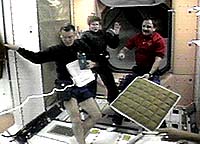| . |  |
. |
 Understanding Post-Flight Fainting
Understanding Post-Flight FaintingIrvine - July 14, 2000 - Fainting after extended bed rest or by astronauts after space flight may be caused by changes in the levels of a molecule known for its role in regulating blood pressure, a UC Irvine College of Medicine research team has found. The study is the first to identify the molecule nitric oxide as a factor in controlling blood pressure in different parts of the body when adapting to the Earth's gravity; most current research instead focuses on other chemicals that control pressure. If the findings work in humans, they could result in improved treatments for fainting spells that are often experienced by patients after long periods of bed rest and by astronauts returning from space. The findings appear in the July issue of the Journal of Applied Physiology. Prolonged bed rest or extended exposure to low gravity during space flight often results in fainting spells, caused by changes in the way blood pressure is regulated in the body. When standing on Earth, blood pressure is usually higher in the feet than in the head; various chemicals work to constrict blood vessels in the feet, forcing more blood to flow to the brain. In a standing position under the effects of gravity, normal blood pressure is usually much higher in the feet than in the head. But when a person who has adapted to low gravity returns to Earth, blood vessels in the lower body remain dilated, resulting in low pressure. Blood flow to the brain then decreases, causing fainting. A person standing up or an astronaut returning to Earth then experiences fainting as blood pressure tries again to adapt to gravity. Most people recovering from bed rest can take several weeks to re-adjust to a standing position; astronauts wear constrictive "pressure suits" upon returning to earth to prevent fainting. Dr. Nosratola (Nick) Vaziri, professor of medicine, found that rats that had adapted to an environment that simulated low gravity produced significantly more of the enzyme that makes nitric oxide than did rats in a normal gravity environment. Since nitric oxide dilates blood vessels, the research suggests that the additional amounts of nitric oxide dilated vessels in the lower body, lowering pressure in the head, which made acclimation to a standing position more difficult and led to fainting. "Previous research has focused on chemicals like norepinephrine, which constrict blood vessels, because the researchers thought that gravity must be preventing the chemicals from narrowing blood vessels and forcing blood to flow to the head," Vaziri said. "Instead of looking at why constriction wasn't effective, we looked at whether dilation was too strong; what makes blood vessels in the feet and legs stay too wide, causing the dramatic drops in blood pressure in the head and subsequent fainting. This study led us to determine that nitric oxide was the mechanism in the body that led to fainting after re-exposure to gravity." Vaziri's team found that rats in a simulated low-gravity environment produced more of the nitric oxide synthase enzyme, which produces nitric oxide in the heart, blood vessels, kidneys and brain. Rats that were in an environment sensitive to gravity had no increase in this enzyme. In addition, when the rats in a low-gravity environment were injected with a chemical called aminoguanidine, blood pressure increased. Aminoguanidine inhibits the production of nitric oxide and has been used to treat complications of diabetes without much success. Its activity in this study indicated that the nitric oxide enzyme was the contributing factor to the blood pressure changes and suggests that chemicals that work similarly to it could be used to treat fainting spells in people recovering from extended bed rest or returning astronauts. Nitric oxide has been used in pharmaceutical products for decades; it is the active ingredient in nitroglycerin, a drug long used to improve circulation in the heart. Recently, researchers have uncovered its role in controlling blood pressure, aiding the immune system to fight off invading cells and processing memory in the brain. The sexual dysfunction drug, Viagra, also regulates nitric oxide synthase. "The levels of nitric oxide synthase increased dramatically in the low-gravity rats; these molecules are helping us understand how blood pressure changes in the head and lower body during space flight and after extended bed rest," said Vaziri. "We and other scientists would need to see whether inhibitory chemicals have any other effects on the body before we can determine if this phenomenon is also happening in humans."
SPACE MEDICINE
|
| |||||||||
| The content herein, unless otherwise known to be public domain, are Copyright 1995-2016 - Space Media Network. All websites are published in Australia and are solely subject to Australian law and governed by Fair Use principals for news reporting and research purposes. AFP, UPI and IANS news wire stories are copyright Agence France-Presse, United Press International and Indo-Asia News Service. ESA news reports are copyright European Space Agency. All NASA sourced material is public domain. Additional copyrights may apply in whole or part to other bona fide parties. Advertising does not imply endorsement, agreement or approval of any opinions, statements or information provided by Space Media Network on any Web page published or hosted by Space Media Network. Privacy Statement All images and articles appearing on Space Media Network have been edited or digitally altered in some way. Any requests to remove copyright material will be acted upon in a timely and appropriate manner. Any attempt to extort money from Space Media Network will be ignored and reported to Australian Law Enforcement Agencies as a potential case of financial fraud involving the use of a telephonic carriage device or postal service. |